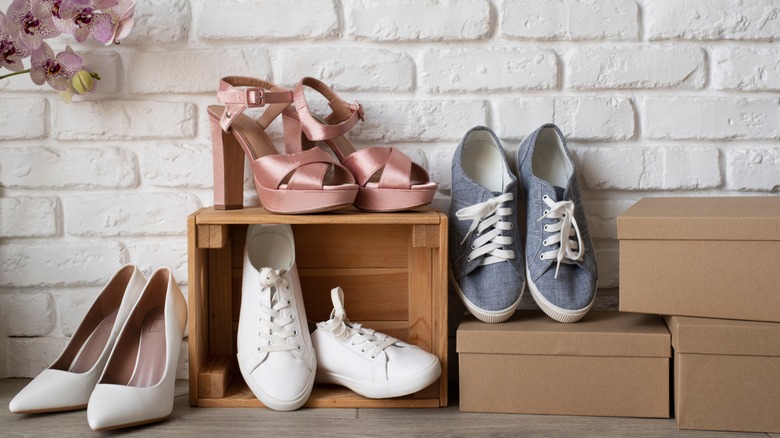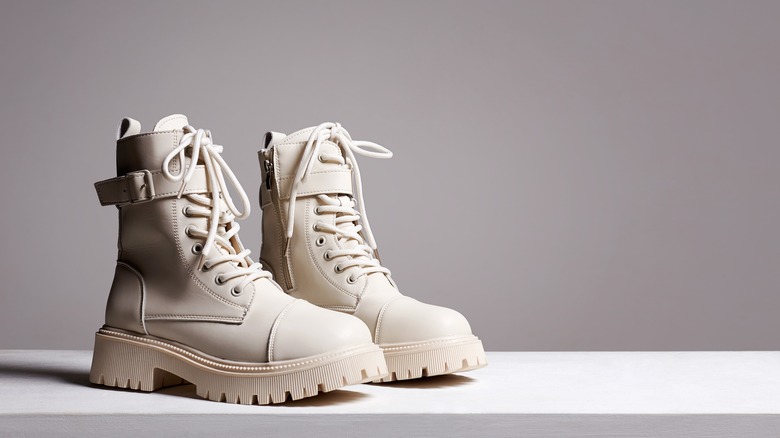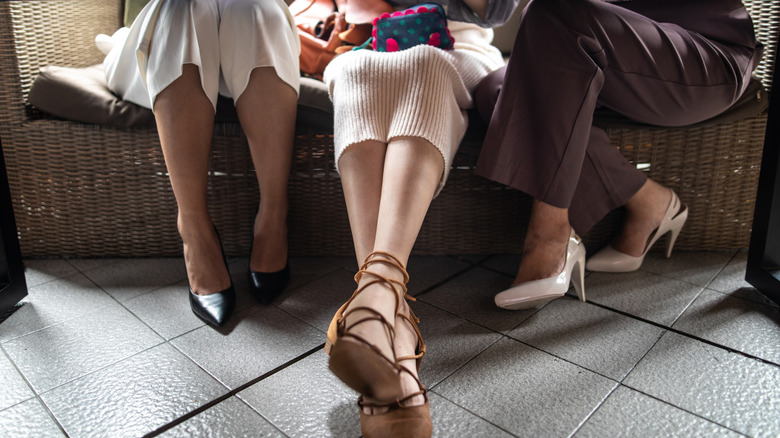'Tabletop Test': The Simple Hack To Determine If It's Time For New Shoes
If there is one rule in the world of wellness and self-care, it's that taking care of yourself and your body is vital to living your best life. With an array of bones, muscles, joints, tendons, organs, and so many more elements within our bodies, it's critical to do what we can to protect our health and keep our bodies thriving as best as possible. It's even better when being able to keep ourselves healthy can be done with very simple wellness hacks that take no more than a few seconds to complete.
That's exactly what the tabletop test for your shoes is all about: quick efficiency to keep your health up to par. Determining the strength, health, and overall stability of your favorite pair of shoes, the tabletop hack is as simple as placing your shoes on, well, a tabletop.
According to Go Feet, not wearing shoes that properly fit, provide sufficient breathability, or have enough cushioning to provide protection from the impact on your joints, can result in adverse effects such as calluses on the skin of your feet, blisters, corns, and even pain to your knees, hips, or back. Utilizing the tabletop test can reveal information about your natural tendencies while walking, like whether you place more weight on one side of your body or rely on one foot over the other while moving around.
Keep a keen eye for asymmetry
The gist of the tabletop test is that you place your shoes next to one another, angled in the same direction, and then assess how the soles align with the flat surface. This trick also applies to any other flat surface and can be used with other types of shoes like flats, heels, boots, and dress shoes.
"You just put it up on the tabletop, at eye level, and you assess whether or not the heel lays flat on the counter and is even with the rest of the shoe," Dr. Jackie Sutera, an innovation lab member for Vionic, a podiatrist-trusted shoe brand, said during a virtual Vionic press event (via PureWow). "Check to see if the sole is old, worn out, or if it's uneven. If it is, it's time to replace it." You also want to look for areas of either shoe that may be more worn out than the other, such as a heel on one shoe that is significantly more worn down and indented than the heel on the other shoe.
As you perform the tabletop test to ascertain the well-being of your shoes, make notes about which activities you're using each pair of shoes for and which endeavors they're for which they're designed. In modern-day manufacturing of shoes, there's a specific technology that goes into each type of shoe, from running shoes to basketball shoes to formal footwear. Be mindful that you aren't mixing up footwear use, like wearing shoes meant for basketball to perform long-distance running.
The importance of tracking the status of your shoes
Banner Health reveals that wearing footwear inappropriately or consistently putting on shoes that have become over-worn can result in detrimental health effects on your feet, ranging from plantar fasciitis to "stress fractures." Since no one is likely to want to endure any of these potential risks of wearing ill-fitting shoes, take this as your sign to do the tabletop test for your athletic shoes and make certain that you're investing in and wearing high-quality, properly fitting shoes at all times.
Switching out your shoes regularly can protect your feet, legs, hips, and all other parts of your body. When you go to purchase new shoes, never try the footwear on early in the morning. It's best to wait until the evening to try on new shoes since feet and ankles are prone to swelling throughout the day, ultimately making that pair of shoes which may have been a snug fit first thing in the morning, an overly-painful and blister-inducing set of footwear by the afternoon.
When the time comes to change out your shoes for new ones, consider recycling options so that your old shoes don't become contributions to environmentally unfriendly landfills. The materials used in many common shoe manufacturing methods, particularly the use of rubber in athletic shoes, can be recycled if the shoes are too over-used to be donated to a local charity shop.


